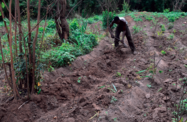With food security becoming a growing concern worldwide, the Nigerian agriculture sector has recently become the focus of multiple investment programmes. The government is taking a proactive approach to boosting domestic production and has designed a plan to help the nation fulfil its agricultural potential.
In January 2011, it was announced that the Commission of Agriculture, Environment and Water Resources of the Economic Community of West African States (ECOWAS) would launch a $900m fund for agricultural development in the region. This year, $30m is to be dispersed. The largest of the ECOWAS member countries, Nigeria has assumed a leading role in the fund, which will be based in Lome, the capital of Togo.
“Nigeria is a blessed country in terms of agriculture. There is a lot of land, water for fisheries and other natural potential. What the country needs now is to do more in tapping these natural agricultural resources,” Ernest Aubee, the principal programme officer at the ECOWAS commission, told the local press.
Investment in Nigerian agriculture has already received a large boost from the N200bn ($1.34bn) Commercial Agriculture Credit Scheme (CACS) launched in 2009. The aim of this programme, which helps to provide affordable lending to local farmers, is to strengthen all stages of the agricultural supply chain, from increasing domestic production of a range of target crops, including rice, cassava and cotton, to improving storage facilities and processing. As of the fourth quarter of 2010, the Central Bank of Nigeria dispersed N96.81bn ($648.6m) in funds for 86 projects. The African Development Bank also announced at the start of 2011 that it has earmarked $100m for Nigerian agricultural projects.
Once Nigeria’s largest foreign exchange earner, agriculture’s relative importance to the economy has decreased in recent decades with the rise of the hydrocarbons industry. In the 1990s, agriculture accounted for around two-thirds of GDP – that figure had dropped to 39% by 2010, according to the National Bureau of Statistics.
A large gap between supply and demand exists for many crops. For example, the country produces 500,000 tonnes of rice, a major staple of the Nigerian diet, while importing 2m tonnes. The nation’s food import bill totals around $3bn, according to British development charity Oxfam. Given the global trend of rising prices, food security is a major concern going forward. Local press reports that prices in Lagos food markets had increased by 30-100% over the course of 2010. However unlike some land-strapped states for which the food supply-demand gap has reached critical levels, Nigeria has around 79m ha of arable land, only around a third of which is under cultivation. In this respect, increasing production is an achievable goal, especially when significant funds are being invested in the sector.
Crop productivity remains a weak point for the country, as Nigeria has some of the region’s lowest yields. According to the US Agency for International Development (USAID), rice yields in Nigeria were 1.44 tonnes per ha in 2006 against an ECOWAS average of 1.61 tonnes. Thailand, by comparison, averages approximately 3 tonnes.
With access to better quality seeds and fertilisers, yields can be improved. USAID has been working on a number of rice programmes throughout the country that have yields of up to 5 tonnes per ha. Meanwhile, the River Basin Development Authority is planning to irrigate 454,021 ha of land by 2012, which should also boost productivity.
Renewed attention to the agricultural sector is starting to pay off, with agricultural exports growing by 15% in 2009 to $378m, according to the Ministry of Commerce and Industry. As of 2008, the country’s top three agricultural products by value were yams, cassava and ground nuts, according to the UN Food and Agriculture Organisation.
The government has acknowledged that agriculture is a central component of turning Nigeria into one of the world’s top 20 economies. The Vision 2020 strategy launched in 2010 set bold targets for the sector, stipulating that 50% of the country’s foreign exchange come from agricultural exports by 2020; aiming to reduce food imports by 50% by 2015 and 90% by 2020; and seeking to lower post-harvest losses by 50% by 2015 and 90% by 2020. With the CACS and the ECOWAS agricultural investment programme, the funds are in place to help turn these goals into a reality.

